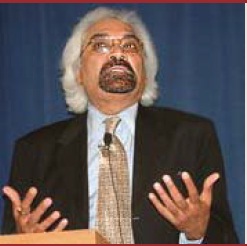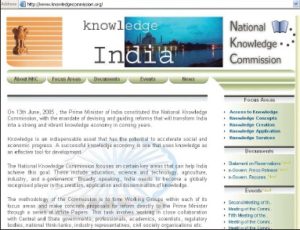 “e-Governance is more about opportunity for administrative reforms than just electronics, IT and infrastructure. If we miss this opportunity to re-engineer government processes before computerisation, the cost will be enormous. The game plan is to leave behind the legacy of the British raj, which has been perfected by the Indian bureaucracy, with a plethora of new layers and silos, each working within departmental boundaries and pet-priorities,” said Sam Pitroda, Head of the National Knowledge Commission (NKC), while releasing the recommendations on e-Governance efforts at the central and state levels at the end of a 3-day brainstorming session held from May 5-7 at Bangalore.
“e-Governance is more about opportunity for administrative reforms than just electronics, IT and infrastructure. If we miss this opportunity to re-engineer government processes before computerisation, the cost will be enormous. The game plan is to leave behind the legacy of the British raj, which has been perfected by the Indian bureaucracy, with a plethora of new layers and silos, each working within departmental boundaries and pet-priorities,” said Sam Pitroda, Head of the National Knowledge Commission (NKC), while releasing the recommendations on e-Governance efforts at the central and state levels at the end of a 3-day brainstorming session held from May 5-7 at Bangalore.
After a series of discussions and reviews of various e- Governance efforts at the Centre and State levels, the National Knowledge Commission (NKC) formed a special group, under the chairmanship of Nandan Nilekani, to study e-Governance. The report of this group was discussed at the Planning Commission and presented to the Minister for communications and information technology and the Minister’s staff. Thereafter, several discussions were held with other stakeholders including the Administrative Reform Commission. Based on these discussions we are convinced that e-Governance is more about an opportunity for administrative reforms than merely about electronics and information technology and infrastructure. We are pleased to submit our recommendations on e-Governance which broadly relate to Processes and Standards, Infrastructure and Organisation as follows:
1. Government process reengineering before any computerisation – At present the e-Governance efforts are primarily based on computerizing age-old processes left behind by British Raj and compounded by a plethora of new layers and silos by Indian bureaucracy, each working within departmental boundaries and pet-priorities. As a result we are computerising cumbersome processes and hence not commensurately benefiting from it. Simply digitising the existing government processes merely adds an additional layer of expense, complexity, delay and confusion. In our judgment, now is a unique opportunity in the history of India to leave behind the British Raj and re-engineer and modernise Government processes to build a new India of the 21st century. Hence it is essential that we first redesign the government processes keeping the citizen at the centre, providing hassle-free enablement of citizens, businesses, producers and consumers, replacing the old mistrust and control regime from the British Raj. This redesigning of government processes will drastically reduce the numbers and duration of successive steps required to obtain services. It will also provide traceable records; enable enforcement of individual performance, accountability, efficiency, productivity as well as transparency of policies and processes.

2. 10 to 20 Important Processes and Services – To make an immediate impact on citizens it is critical to identify and simplify important processes and services, say 10 to 20 to begin with, which are currently cumbersome, bureaucratic and prone to unnecessary delays and even corruption. These processes can be simplified and made available as web-based services. Initially, these services could
include birth certificate, death certificate, proof of residence, ration/ ID cards, etc. Other processes can be added over a period of time. This approach will require each state to implement these processes in concert and learn from each other.
3. Common Standards – At present various state governments are doing their own thing to selectively computerise their processes and provide e-Governance. Many of these programmes are vendor driven and not scalable. It is critical to develop and enforce citizen/business entitlement standards uniformly over all states and central ministries and functions, spanning from voting, taxes, certificates, financial products, law-enforcement and welfare for individuals, properties of land, institutions, businesses etc. These standards should not be hardware-centric and vendor dependent but should enable easy participation by any State, Panchayat Institution, business, NGO or citizen, whenever they decide. These standards, templates and data formats must be designed carefully by teams of experts drawn from government, IT companies, academia, R & D institutions and users/stakeholders who understand latest trends, technology, software, user interfaces and interoperability requirements. We recommend these new standards be followed by all state governments. At the same time, we are conscious of the need to incorporate some of the standards followed by state governments.

4. Best Practices and Lessons from the Past – A great deal of work has already been done in various central ministries and in state governments. The key is to learn from these and design best practices that are affordable and applicable nationwide to ensure ease of use and interoperability. We note that the government’s own offices, laboratories, directorates etc., have immense amount of useful and relevant data (e.g. seven centres of the National Bureau of Soil Science and Land Use Planning – NBSSLUP), which needs to be digitised and made publicly accessible for use and analysis. This requires making the data collected by one agency, available across all agencies as well as the public, subject to their sensitivity to national security.
5. National Infrastructure – It is important to provide nationwide secure broadband infrastructure and associated hardware, software and hosting facilities with easy access at all levels. This infrastructure should be based on user-pays principle and Public-Private partnership in investments and mutual accountability and efficiency. This infrastructure creation should be led by the central government to enforce a high level of security, uniformity and standards at every interface, regardless of state language, culture, legacy and financial health.
6. Web-based Services – To enforce standards and to keep the governance uniformly responsive and transparent, it is recommended that state governments use templates created by the central government to offer localised data and services in Indian languages. In this model, the private sector can invest in creation of access-infrastructure and building relevant business models for user-fee collection and its sharing across all stakeholders, to ensure sustainability and adaptation for future needs. This also implies that all public institutions will make sure that all public data is available on the web.
 7. Open Source Software – Because of the enormous size and scope of the e-Governance effort in India and because of the availability of globally recognised software talent of Indians, we must actively encourage wherever possible open source software implementations and open standards. This will allow us to have cost-effective solutions and help develop open software products and standards. It will also help improve scaling up as well as minimise delays caused by repeat tendering.
7. Open Source Software – Because of the enormous size and scope of the e-Governance effort in India and because of the availability of globally recognised software talent of Indians, we must actively encourage wherever possible open source software implementations and open standards. This will allow us to have cost-effective solutions and help develop open software products and standards. It will also help improve scaling up as well as minimise delays caused by repeat tendering.
8. Specialist CITO (Chief Information Technology Officer)– Each state and major central government departments must create an empowered chief information technology officer, with relevant expertise and skills in the domain subject and IT usage. These posts must be filled on open recruitment and draw the best and the brightest from India’s technologically qualified talent. These officers should be paid market salary and have a three-year contract with the government, renewal of which will be dependent on performance.
9. New National Programmes – As government plans to spend hundreds of thousands of crores on Bharat Nirman, rural employment guarantee scheme, urban development initiatives etc., it is recommended that we mandate that each of these programmes begin with well engineered e-Governance implementation and web-interface that ensures speedy delivery, productivity and efficiency. It is recommended to invest 1 to 2 percent of the national program budget in establishing new processes and associated e-Governance infrastructure to improve delivery and reduce leakages.
10. Focused Organisation –For national e-Governance to succeed, it is critical to create an appropriate central organisation with structures that can operate in mission mode, with full autonomy and accountability. It is recommended that we create an organisation with a CEO, with board members drawn from IT industry and government to redesign processes and procedures, to represent multiplicity of stakeholders and diversity in domain expertise, and to drive the National e-Governance Plan with facilitation from the CIT Ministry.
The task of this organisation shall include but not be limited to:
a) Administrative reforms related to process re-engineering
b) Providing and maintaining common national ICT infrastructure for e-Governance
c) Providing leadership and framework for implementation with immediate focus on selected mission mode projects, and
d) Providing neutral consulting framework and standards for e-Governance with the help of CITOs
We need to re-engineer our processes first, to change our basic governance pattern for simplicity, transparency, productivity and efficiency, select 10 to 20 important services that make a critical difference, offer web-based services, develop common standards and deploy common platform/infrastructure for e-governance to make it citizen-centric.
As a next step we recommend focusing on the organisational issues related to re-engineering government processes with strong committed leadership, autonomy, flexibility, clarity of purpose, predefined deliverables, measurable milestones and periodic monitoring in order to implement national e-Governance programme within 3 to 5 years.
(Source: http://www.knowledgecommission.org/)
Be a part of Elets Collaborative Initiatives. Join Us for Upcoming Events and explore business opportunities. Like us on Facebook , connect with us on LinkedIn and follow us on Twitter, Instagram.











